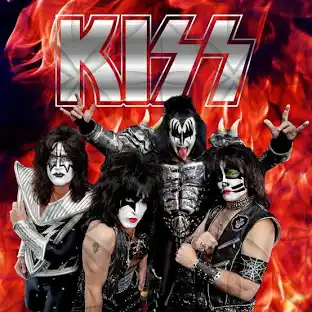KISS: Overview and Impact as Music Artists
KISS, formed in New York City in 1973, is an American rock band known for their elaborate stage performances, iconic face paint, and larger-than-life personas. The original lineup of Paul Stanley (vocals, rhythm guitar), Gene Simmons (vocals, bass), Ace Frehley (lead guitar), and Peter Criss (drums) created a theatrical approach to rock music that revolutionized live performances. With their hard-hitting rock anthems, high-energy concerts, and savvy marketing, KISS became one of the most successful and enduring bands in rock history, selling over 100 million records worldwide. Their influence extends beyond music to pop culture, branding, and entertainment, making them icons of the genre.
Key Phases in KISS’s Career
- Formation and Early Success (1973-1975): Inspired by glam rock and bands like Alice Cooper, Stanley and Simmons formed KISS, emphasizing visual spectacle and a theatrical approach to performance. Their self-titled debut album, KISS (1974), introduced their raw rock sound, while their breakthrough came with the live album Alive! (1975), featuring anthems like “Rock and Roll All Nite.” This album captured their explosive live energy and catapulted them to stardom.
- Golden Era and Commercial Peak (1976-1979): KISS reached the height of their popularity with albums like Destroyer (1976), featuring hits like “Detroit Rock City” and “Beth,” and Love Gun (1977). Their distinctive characters—The Demon (Simmons), Starchild (Stanley), Spaceman (Frehley), and Catman (Criss)—became global icons. During this period, their concerts set new standards for live rock performances, incorporating pyrotechnics, levitating drum kits, and fire-breathing theatrics.
- Lineup Changes and Makeup-Free Era (1980-1996): Internal tensions led to the departures of Frehley and Criss in the early 1980s, marking a period of transition. KISS removed their iconic makeup in 1983 with the release of Lick It Up, signaling a new era focused on their music rather than their image. While their popularity waned during this period, they maintained a loyal fan base and achieved moderate success with albums like Animalize (1984).
- Reunion and Return of the Makeup (1996-2000s): In 1996, the original lineup reunited for a highly successful worldwide tour, bringing back their signature makeup and costumes. Their live performances during this period reaffirmed their reputation as one of the greatest live bands in rock history. This era included a resurgence in popularity, with new studio albums like Psycho Circus (1998) and a renewed focus on their iconic image.
- Legacy Tours and Farewell (2010s-Present): KISS announced their End of the Road World Tour in 2019, celebrating nearly five decades of music and performance. Despite changes in lineup, with Tommy Thayer and Eric Singer replacing Frehley and Criss, the band continues to draw massive crowds, showcasing their enduring appeal and influence.
Kiss Double Platinum Playlist:
Musical Style and Themes
KISS’s music is characterized by its energetic rock anthems, driving riffs, and sing-along choruses. Their songs often revolve around themes of rebellion, love, and the rock-and-roll lifestyle. Tracks like “I Was Made for Lovin’ You” and “Shout It Out Loud” exemplify their ability to craft catchy, high-energy hits. Their music blends elements of hard rock, glam rock, and heavy metal, appealing to a broad audience and setting the stage for later rock subgenres.
Legacy and Influence
- Revolutionizing Live Performances: KISS redefined what it meant to be a live rock band, incorporating theatrical elements, elaborate stage designs, and audience engagement. Their performances influenced countless artists and bands, including Alice Cooper, Mötley Crüe, and Gwar, who embraced their combination of music and spectacle.
- Icons of Branding and Marketing: KISS was one of the first bands to master the art of branding. Their logo, face paint, and characters became globally recognized symbols, and their extensive merchandising—including everything from action figures to pinball machines—set a new standard for commercializing a band’s image.
- Influence on Glam Rock and Metal: KISS inspired a generation of glam rock and heavy metal bands with their flamboyant style, high-energy music, and rebellious attitude. Bands like Twisted Sister, Poison, and Def Leppard cite KISS as a major influence on their music and image.
- Pop Culture and Global Reach: KISS’s impact extends beyond music into popular culture. They’ve appeared in films, TV shows, and comic books, reinforcing their larger-than-life personas. Their influence on music, fashion, and entertainment has transcended generations, making them cultural icons.
- Dedication to Fans: Known for their close relationship with their fan base, KISS created the KISS Army, one of the most dedicated fan communities in rock history. Their connection with fans has helped sustain their career for decades, and their commitment to putting on unforgettable shows has made them legends in live performance.
Conclusion
KISS’s legacy is one of spectacle, innovation, and enduring appeal. Their ability to blend theatricality with hard rock and their mastery of branding and marketing revolutionized the music industry. With a career spanning nearly 50 years, KISS remains a symbol of rock-and-roll’s rebellious spirit, and their influence continues to shape the worlds of music, performance, and popular culture.
Kiss YouTube Channel:
https://www.youtube.com/channel/UCyOw2FDjfQOFQH7paKxNVvA
References:
- Leaf, D., & Sharp, K. (2003). KISS: Behind the Mask – The Official Authorized Biography. Warner Books.
- “KISS.” Rock and Roll Hall of Fame, inducted in 2014.
- “The Evolution of KISS: From Makeup to Global Icons.” Rolling Stone, 2020.
- Simmons, G. (2002). KISS and Make-Up. Crown Archetype.
- “KISS: A Legacy of Rock and Roll.” AllMusic, biography by Greg Prato.


Leave a Reply